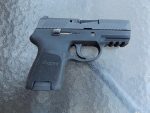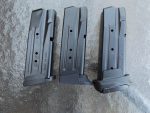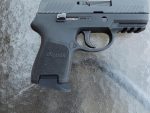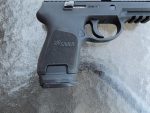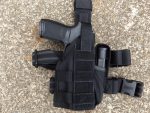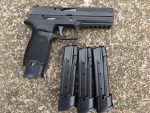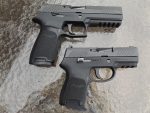The Federal government is on the wrong track most of the time. If there is a hard, wrong, or difficult way to do something, they do it, nearly every time. I know this from first-hand experience when I worked for a large detective agency and we often bid on uniform guard services for the Federal government. It’s not quite as simple as being the lowest bidder, as many believe. There are a good number of loopholes involved in bidding on FedGov services, including whether your company has the capability to meet the requirements. They want to know if your business has enough cash flow, enough employees, and the list goes on and on.
When the US Military requested a new handgun back in the 1980s, the list of things that they wanted the gun to do were endless. After the first round of testing, none of the handguns had passed the testing procedures, and it had to be done all over again. Some gun companies opted out, and some new gun companies decided to give it a try. The end result was that Beretta won and supplied the Model 92, called the M9 in the military. They are basically the same gun, for all intents and purposes, with just a few slight differences. Of course, this led to protests over the bidding process and the final selection when one gun company accused the other of penciling in their bid price after hearing the others’ bids. Soon after, the military also adopted the SIG Sauer P228 9mm handgun for plain clothes CID officers, and it is called the M11.
Let’s fast forward to several years ago when the military decided that it needed another new handgun for the services. However, this time around, there weren’t too many bidders. I believe it was because the gun companies didn’t want to get involved in a selection process that could take years, maybe a decade since nothing moves fast when dealing with the FedGov. There were only a few gun makers willing to jump through the red tape and provide gun samples, based on the 300+ pages of requirements for the new handgun.
It was recently announced that SIG Sauer [2] won the bid for the new “Modular Handgun System”. The military didn’t want just a single gun to do everything they think they wanted it to do; it had to be “modular”. You had to be able to change it to fit different missions, different sized people, and meet other requirements. For the most part, there is no one-size-fits-all, when it comes to just about anything.
Following the successful SIG P250 came the SIG Sauer P320 series of handguns. The military, in their finite “wisdom”, didn’t even spec what caliber of handgun they were looking for. Everyone assumed they wanted another 9mm. Well, even though the testing is over, we still don’t know what caliber the military wants. The nation’s leading law enforcement agency, the FBI, recently went back to the 9mm after using the .40S&W for many years. The advances in bullet construction made the switch easy. The .40 S&W does tend to have some serious recoil, and smaller-statured officers were having a difficult time qualifying. If they couldn’t qualify on the range, their real-life shootings weren’t going to be much better. So, now there is a mad rush by law enforcement all over the country to dump their .40 S&W caliber handguns and switch back to the 9mm.
Let’s take a look at the Modular Handgun System [4] that SIG came up with. Please check out their website for all the different models. We don’t want to bore our readers to death with the seemingly endless choices the P320 comes in. However, we will mention that the P320 can be had in 9mm, .357 SIG, .40 S&W, and .45ACP. Plus, there are full-sized, carry, compact, and subcompact versions. However, it’s not that easy to make a choice. SIG came up with something very unique a few years ago in their P250 model, which we reviewed on SurvivalBlog.com, in that the serialized part of the gun isn’t the polymer frame; rather, it is a stainless steel chassis that is easily removed from the polymer grip and inserted into different sized grips.
So, if you purchase one SIG Sauer P320 model, you can change it over to different sizes, from the sub-compact to the full-sized gun and everything in between with shorter frames, longer barrels, and slides, and everything you can think of, seriously! If ever there was one handgun that you can consider as truly modular, this is it!
I happened to have two different samples of the SIG Sauer P320, both in 9mm. First is the sub-compact, and then we have the TAC OPS that is a full-sized version with a little something more to it compared to the standard full-sized version. Now, remember, I can take the sub-compact model and remove the stainless steel chassis from the frame, install it in another frame, then add the right size slide and barrel and magazine, and I have a new gun, but it is still the same gun, because it has but one serial number. It’s easier to do than explain.
Let’s take a look at the sub-compact model first. The P320 is a striker-fired handgun, unlike the P250, which was hammer-fired. The trigger pull on the P320 model is very short and crisp, considering it is a striker-fire handgun. It might well be the best striker-fired trigger pull out there, bar none. It is “that” good. The sub-compact has a barrel that is only 3.6 inches long, and the gun only weighs 24.9 oz and is 1.3 inches wide. We can now confuse ourselves more; the standard magazine capacity is 12 rds; however, you can also use the 15-rd mag from the compact model, by slipping a sleeve over the magazine, and you can use the 17 or even 21 round mags in the sub-compact model. What?
I don’t especially like the stubby 12-rd mag; my pinky finger just hangs below the magazine. So, I found some after-market mag floor plates, which were priced at $20 each. They work great. My pinky finger fits nicely on the gun now, as does it work great with the 15-rd mag with the sleeve over it. My sub-compact model came standard with night sights, too, which is very nice. There is no manual safety, and none is needed. However, I understand that the US Army may require a manual safety on some of the guns they order.
The TAC OPS model was designed for SWAT teams and elite military units. It is a full-sized gun with a 4.7-inch barrel, and it weighs 29.5 oz. It has a rear night sight, and the front sight is also a night sight; however, it is also a fiber optic night sight. That green fiber optic really shines (no pun intended) when you are outdoors. It is also 1.3 inches wide. The TAC OPS comes with four, count ‘em– four, twenty-one round magazines. These alone sell for about $60 each, and you can use these mags in the sub-compact model; they just stick out of the bottom of the grip quite a bit. I don’t believe SIG makes this model any longer; it’s not on their website, which is too bad. But they still come with regular SIG Lite night sights just the same.
Both the sub-compact and the TAC OPS come with a Picatinny rail; however, you can purchase a frame for about $40 directly from SIG without the Picatinny rail for the sub-compact. Now, if all this isn’t enough, you can swap out frames. Again, just removed the serialized stainless steel chassis from the gun, and slip it into a frame that is bigger or slimmer (to fit your hand better). My sample, on the TAC OPS, came with the medium grip, as it did on the sub-compact version.
While the possibilities aren’t exactly endless on the different configurations you can make the P320 into, there are a lot of different ways you can have many different guns just by purchasing one gun and then swapping out the chassis and installing it. Plus, it only takes a minute with no tools to do this, and you can design a gun to your liking. The frames can be purchased directly from SIG, because they do not have the serial number.
I carried the P320 sub-compact for almost six months on a daily basis, in between testing other handguns. I liked it a lot! SIG also provides a plastic paddle holster with this one but not with the TAC OPS for some reason. I don’t like paddle holsters, so I carried the sub-compact in a leather holster I modified to fit a different gun. The only complaint I had with the sub-compact model is that it just feels a little bit too chunky in my hand. The full-sized TAC OPS is the same width, but it didn’t feel chunky. Go figure!
I didn’t carry the TAC OPS on a daily basis. I only carried it a few times, and it was in a Blackhawk Products ballistic Nylon holster, a genertic sort, but the gun rode just fine in it. Quite honestly, the full-sized gun isn’t meant for concealed carry, but you can conceal it with the right holster and covering garment. You can, as mentioned, swap out the serialized chassis from the TAC OPS and put it in a sub-compact, compact, or carry-sized gun. Did we happen to mention that the P320 truly is a modular handgun system? It is, in many respects.
Up first for testing was the sub-compact model. I had several boxes of 9mm FMJ reloads I got from the local gun shop. They are manufactured locally here in Oregon. I had one failure after another, either to feed or fully extract the empty brass when it was ejecting. It was just barely dribbling out of the slide, as it was very under-powered ammo. It wasn’t the gun. I tried this ammo in several other 9mm handguns and had the same problem. Whew!
From Black Hills Ammunition, I had their 115-gr JHP +P, 124-gr JHP +P, 115-gr FMJ, 115-gr EXP HP, 124-gr JHP, and 115-gr Barnes TAC XP, all-copper hollow points. From Buffalo Bore Ammunition, I had their 147-gr standard pressure sub-sonic Heavy 147-gr JHP, 147-gr Hard Cast FN +P, 115-gr Barnes TAC XP, all-copper hollow point, +P+, 1240gr FMJ FN Penetrator +P+ round, and their 124-gr JHP +P+ loads. There were zero malfunctions of any sort with good ammo. It was just that reloaded stuff that was way under-powered. Even the +P+ ammo was easy to shoot in the sub-compact and a breeze in the full-sized TAC OPS model. In all, I fired close to 1,000 rounds through both guns, over the course of several months.
Accuracy testing was from 25 yards, even with the sub-compact model, resting it over a sleeping bag over the hood of my pickup truck. Best accuracy was from the TAC OPS, and it was the 147-gr sub-sonic heavy JHP Load from Buffalo Bore. If I was on my game, I could get 2.5-inch groups, and with the sub-compact, the best group was with the Black Hills 124-gr JHP load right at three inches. That is outstanding from both guns. The little sub-compact didn’t give up much to the big brother in the accuracy department.
For concealed carry, the sub-compact was nice, but it just felt too chunky in my hand for some reason. The TAC OPS, with the 21-round magazines sticking out of the butt of the gun, was too big for concealed carry, but it was great for duty work; however, I placed a 17-rd mag in the TAC OPS and it fit flush with the butt of the gun. Still, it was a tad too big for my own every day concealed carry. We have a carry version and a compact version from SIG, and you can buy all the parts you need directly from SIG to put that chassis into them and have several guns per se to fit your needs. Blackhawk Products [10] sent me one of their tactical thigh holsters, and after a little adjusting the TAC OPS fit nicely. It’s just the ticket for tactical work!
I think, for once, that the US Army made a very wise decision going with the SIG Sauer P320. It truly is a modular handgun system, and there is nothing on the market that comes close to this handgun for versatility. If you can’t make this handgun into whatever handgun you want, I don’t know what you are looking for. And, don’t forget, it is available in several other calibers, too.I just wanted to mention the trigger pull one more time. It is probably the best of the best on striker-fired handguns; the only thing that comes close, or maybe could tie it is the H&K VP9 , and it probably isn’t as nice as the P320 trigger pull is.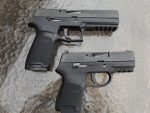 [11]
[11]
Prices are all over the place on the P320, depending on which version you pick and what caliber. I got the sub-compact used but 100% as-new, and the price was so low I couldn’t pass it up. I had to have it. Then when the gun shop got in a couple TAC OPS, I couldn’t pass on it, either, so I worked a trade. I will say though, for what you are getting in any version of the P320, it is one steal-of-a-deal, considering what you are getting and with night sights, the gun is lower priced than you’d expect from SIG Sauer. Plus, it is made in the USA!!!
– Senior Product Review Editor, Pat Cascio [12]
